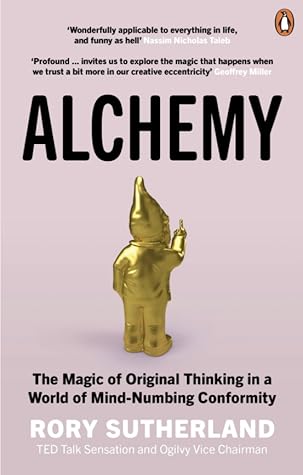More on this book
Community
Kindle Notes & Highlights
Read between
May 7 - June 7, 2019
In the 1950s, the General Mills food company launched a line of cake mixes under the Betty Crocker brand that included all the dry ingredients, including milk and eggs. All you needed to do was add water, mix and stick the pan in the oven – what could go wrong? However, despite the many benefits of this miracle product, it did not sell well, and even the Betty Crocker name could not convince anyone to buy it. General Mills brought in a team of psychologists to find out why consumers were avoiding it. One of their explanations was guilt: the product was so damned easy to make compared to
...more
This highlight has been truncated due to consecutive passage length restrictions.
Demanding people do the right thing and for the right reason is setting the bar rather too high. When Ogilvy was asked to increase the level of waste recycling in British homes we made the suggestion of shelving all discussion of what a household thinks about the growth of landfill or the loss of polar bears; instead we suggested that the principal behavioural driver of recycling is to do with circumstances rather than attitude. Put bluntly, if you have two bins in your kitchen, you’ll separate your recyclable rubbish and recycle quite a lot, but if you have only one bin you probably won’t.
...more
This highlight has been truncated due to consecutive passage length restrictions.
Robert Cialdini has observed that, as you are closing a sale, the admission of a downside oddly adds persuasive power: ‘Yes, it is expensive, but you’ll soon find it’s worth it,’ seems to be a strangely persuasive construction – explicitly mentioning a product’s weakness enables people to downplay its importance and accept the trade-off, rather than endlessly worrying about the potential downside. If you are introducing a new product, it might pay to bear this in mind.
A few hours before I sat down to write this chapter, I received a parking ticket. It was only for £25 and I was completely to blame, but it nevertheless annoyed me to an extraordinary degree – and it is still annoying me now. Perhaps a parking ticket is made even more annoying because we can see no way of reframing it in a positive light. Could the local authority that issued me with the ticket give me a chance to play the same mental trick on myself as the easyJet pilot – a reason, however tenuous, to feel slightly upbeat about the fine? For instance, how different would I feel if I was told
...more
I once examined a breakdown of what my local taxes are spent on: it seemed that I paid £25 per year for weekly refuse collection – reframing this as 50p per week, I was struck by what good value it was. For less than the cost of a stamp, someone would come to my house and remove and dispose of several bags of refuse; suddenly the council seemed more impressive than they had before. One problem with governments is that they generally hate hypothecation, the system whereby taxes are ring-fenced and spent on a pre-defined area of activity. Instead, taxation tends to go into one pot, before being
...more
This highlight has been truncated due to consecutive passage length restrictions.
A strictly logical approach to problem-solving gives the reassuring impression that you are solving a problem, even when no such process is possible; consequently the only potential solutions considered are those which have been reached through ‘approved’ conventional reasoning – often at the expense of better (and cheaper) solutions that involve a greater amount of instinct, imagination or luck. Remember, if you never do anything differently, you’ll reduce your chances of enjoying lucky accidents.
It seems safer to create an artificial model that allows one logical solution and to claim that the decision was driven by ‘facts’ rather than opinion: remember that what often matters most to those making a decision in business or government is not a successful outcome, but their ability to defend their decision, whatever the outcome may be.
The overly simplistic model of advertising assumes that we ask ‘What is the advertisement saying?’ rather than ‘What does it mean that the advertiser is spending money to promote his wares?’, even though we clearly use social intelligence to decode the advertising we see.


